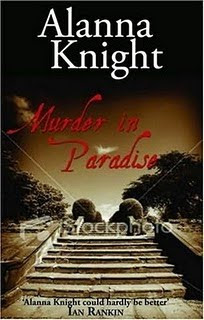Author: Alanna Knight
Copyright: October, 2009 (Allison & Busby); 374 pgs
Series: #14 in The Inspector Faro Mysteries
Sensuality: Some mild references
Mystery sub-genre: British Police Procedural
Main Character: Inspector Jeremy Faro
Setting: 1860 Kent countryside
Obtained book through: LibraryThing
The novel is comprised almost entirely from a flashback of Inspector Faro of one of the darkest moments of his career - the chase of the notorious Macheath, a murderer and cunning jewel thief. He has been sent, seemingly as punishment from a petty superior, alone to chase Macheath. Upon arriving in town Faro finds an old school chum is living with several famous artists at the Red House and insists that Faro be a guest. His old school chum, Erland, confides that he is ecstatic with his upcoming wedding and Faro simply must stay and attend.
When Faro is introduced to Erland's fiance, he recognises her instantly as the woman who got away with poisoning a lover a few years prior. This aspect of the story embellishes on a historical account of Madeleine Smith who had received a "Not Proven" verdict in a highly publicized trial of that time (referred to as Victorian Scotland's trial of the century) . Speculation of her guilt or innocence still surrounds her today and the trial was considered very risque for that time. When Faro learns that a wealthy acquaintance has recently proposed to Lena (aka Madeleine) the situation is far too similar to the motive for the last lover's death and Faro is undecided while he watches a drama unfold around his chum Erland.
Close on the heals of Faro arriving in town, a manor house has a minor break-in that Faro believes was actually Macheath gathering some supplies while he is on the run. But the maid at the manor house goes missing and the local towns people are unconcerned since she had a "loose" reputation. Is Macheath still around or has he long since moved on? How does the missing maid figure in? What about the pot-shot at Faro one morning?
Changing the subject he said quickly, "You get along very well with Lena."There are some interesting characters in the story, the seemingly moody loner in a cabin adjoining the manor house's property, or the local constable who is the epitome of small town police with nothing more than an occasional drunk for experience, to the colorful and eclectic assortment of people at Red House. Faro himself comes across as fallible and young, with a few missteps here and there, but a decent bloke trying to determine the best course in confusing circumstances. The characters are all well done - except perhaps Macheath who you only know by reputation for the most part.
She nodded. "I do indeed. She is my best friend. From the moment she arrived with Erland. I would do anything for her. She is a wonderful person, so kind and understanding with everyone."
They were no longer alone in the garden. A lot of unseen activity nearby indicated the gardeners were approaching.
A group of hooded figures came into view. Sacking over their heads and shoulders, protection from the weather and doubtless the falling apples they gathered, transformed them into medieval figures from an ancient pastoral tapestry, a picture of harmony in keeping with their surroundings as they toured the gardens with their wheelbarrows.
 The setting of Red House is also a case of incorporating some more specific history into the story - Red House truly does exist and was an artist's bohemian getaway with William Morris and the Pre-Raphaelites in residence. It provides a great setting, lending some gothic touches to the tale as well as some authenticity. It makes the tale of Inspector Faro seem a bit more real.
The setting of Red House is also a case of incorporating some more specific history into the story - Red House truly does exist and was an artist's bohemian getaway with William Morris and the Pre-Raphaelites in residence. It provides a great setting, lending some gothic touches to the tale as well as some authenticity. It makes the tale of Inspector Faro seem a bit more real.The writing style is modern but reminiscent of Victorian times with an emphasis on a running narrative and less on action scenes. This is a difficult point - some love this style and others hate it. It takes me awhile to get into the story but once I have adapted to it I can enjoy it. That was the case here as well - it took awhile for me to be enveloped in the story. This writing style can easily feel slow, and it certainly did feel slow.
It isn't until the last few chapters that things really start cooking, as though the various ingredients had simmered long enough and everything was coming to a boil at once. There was a surprise element that really doesn't surface until late even though slightly hinted at earlier on - but I felt a little blindsided by that development. Was it literary cheating - you will have to read it to decide for yourself. As historical police procedurals go, I enjoyed it and will probably read another in the Faro series - but to be honest, it wasn't in my favorites list either.
If you enjoy Victorian mysteries this may be just what you are looking for, but if you crave more modern or spicy tales this may not sustain you.




Thank you for this recommendation. The author is unknown to me and I always like to read something and someone new.
ReplyDelete